Corentin Cadiou
CNRS @ IAP, Paris
Early Milky-Way galax(ies) in the Megatron simulations
Co-Is: Harley Katz, Martin Rey
Collaborators: Oscar Agertz, Jeremy Blaizot, Alex J. Cameron, Nicholas Choustikov, Julien Devriendt, Uliana Hauk, Gareth Jones, Taysun Kimm, Isaac Laseter, Aayush Saxena, Sergio Martin-Alvarez, Kosei Matsumoto, Camilla T. Nyhagen, Autumn Pearce, Francisco Rodriguez-Montero, Victor Rufo-Pastor, Joki Rosdahl, Adrianne Slyz, Richard Stiskalek, Anatole Storck, Wonjae Yee
High-\(z\) galaxy formation challenges
What is setting the structure in the CGM?
Can we reproduce the diversity of high-\(z\) spectra?
Observational prospects of Pop. III stars?
Bridge high-\(z\) JWST/ALMA to Gaia?
[…]

Harikane+24

Cullen+24

Cameron+24
Typical path from sims to observations

Lots of assumptions
(equilibrium, geometry, element abundances, …)
\(\rho, T, Z,v\)
sometimes \(n_\mathrm{H}, n_{\mathrm{H^+}}, n_\mathrm{He}, n_\mathrm{He^+},n_\mathrm{He^{2+}},n_\mathrm{e^{-}}\)
Physical space
Observable


Megatron suite of simulations
- On-the fly radiative transfer,
- 81-ions non-equilibrium thermochemistry,
- Chemical enrichment from SN and stellar winds,
- Milky-Way progenitor,
- 4 “high-resolution” sims at \(10\,\mathrm{pc}\) comoving,
- 3+1 “low-\(z\)” sims at \(23\,\mathrm{pc}\) proper.
\(\Sigma\)HI
\(\Sigma\)HII
\(\Sigma\)MgII
\(\Sigma\)OII
Mocks in absorption:
Main object, \(z=4\), raw file outputs, no postprocessing
Mocks in emission:
Main object, \(z=9\), w/ nebular cont. Pyneb (Luridiana+15) & coll. Chianti (Del Zanna+21)
The Megatron suite of simulations

The Megatron suite of simulations

4 High-z ISM
The Megatron suite of simulations

4 High-z ISM
3+1 "low"-z CGM
State of the CGM of a MW progenitor at \(z \approx 3-4\)

CGM at \(z \approx 3-4\)



CGM at \(z \approx 3-4\)



CGM at \(z \approx 3-4\)
CGM at \(z \approx 3-4\)
Is the CGM in equilibrium?
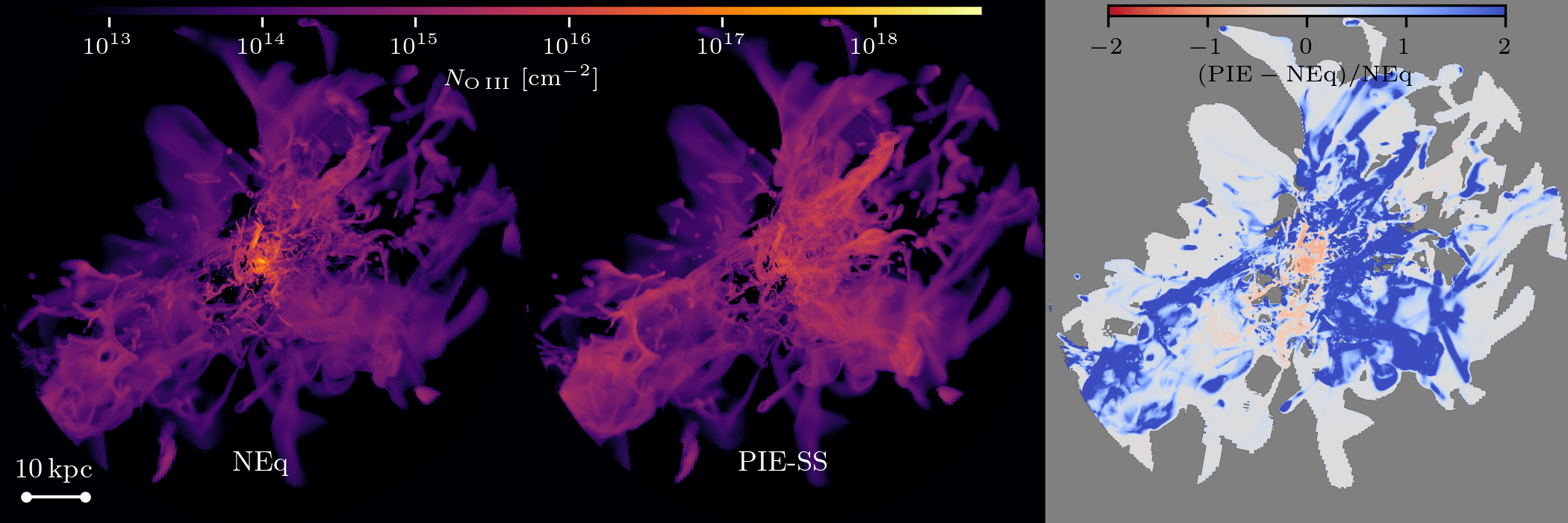
Relax to photo-ionisation equilibrium (PIE)
No local radiation field, no time-dependence, assume \(n_\mathrm{e}\) dominated by primordial species, self-shielding
\[\frac{\mathrm{d}n_i}{\mathrm{d}t} = 0 = \text{Recomb} + \text{Collisional} + \text{UVB}\]
CGM at \(z \approx 3-4\)
Is the CGM in equilibrium?

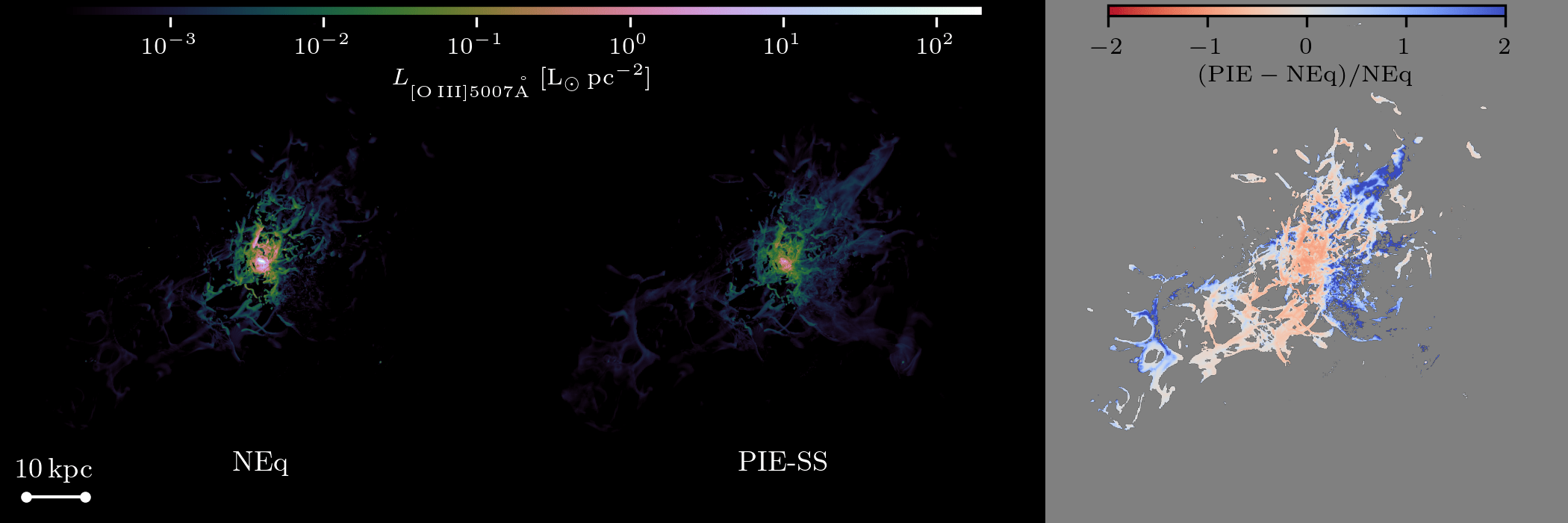
CGM at \(z \approx 3-4\)
Is the CGM in equilibrium?


CGM at \(z \approx 3-4\)
Is the CGM in equilibrium?

NEq.
PIE
Assuming PIE ⇒ biased towards colder/denser gas
\(T\)
\(n_\mathrm{H}\)
CGM at \(z \approx 3-4\)
Is the CGM in equilibrium?


\(\pm0.5\,\mathrm{dex}\)
CGM at \(z \approx 3-4\)
Is the CGM in equilibrium?


Non-equilibrium effects:
\(\Delta(T, n_\mathrm{H}) \sim 0.2-0.5\,\mathrm{dex}\)
⇒ \(\Delta L \sim 1\,\mathrm{dex}\)
for some lines
CGM at \(z \approx 3-4\)
CGM out of equilibrium: why?


40 kpc
- Local radiation dominate locally over UVB
Anisotropic effects
- Recombination lag
\(t_\mathrm{cool} \ll t_\mathrm{rec}\), worse with time
CGM at \(z \approx 3-4\)
CGM out of equilibrium: why?
- Local radiation dominate locally over UVB
Anisotropic effects
- Recombination lag
\(t_\mathrm{cool} \ll t_\mathrm{rec}\), worse at low \(z\)


Pop. III star formation

Pop. III star formation

A. Storck

Pop. III star formation

At least 2dex gap to observe Pop. III haloes
On their observability at high-\(z\)
Not observable (unless really lucky with a lens)
Not close to UV-bright galaxies (6/10,000 form within \(R_\mathrm{vir}\))

A. Storck
A detour to ultra-faint dwarves

\(z=8\) sim
\(z=0\) data
Excellent agreement between \(z=8\) sim and \(z=0\) local dwarf galaxies

A detour to ultra-faint dwarves

22% Fe-poor UFDs
(not observed!)


1 high-mass PISN
1 Pop. II CCSN
1 low-mass PISN
Pop. III star formation
On their observability at low-\(z\)
High-\(z\) kinematics
ALMA-like observations (at 0.1")
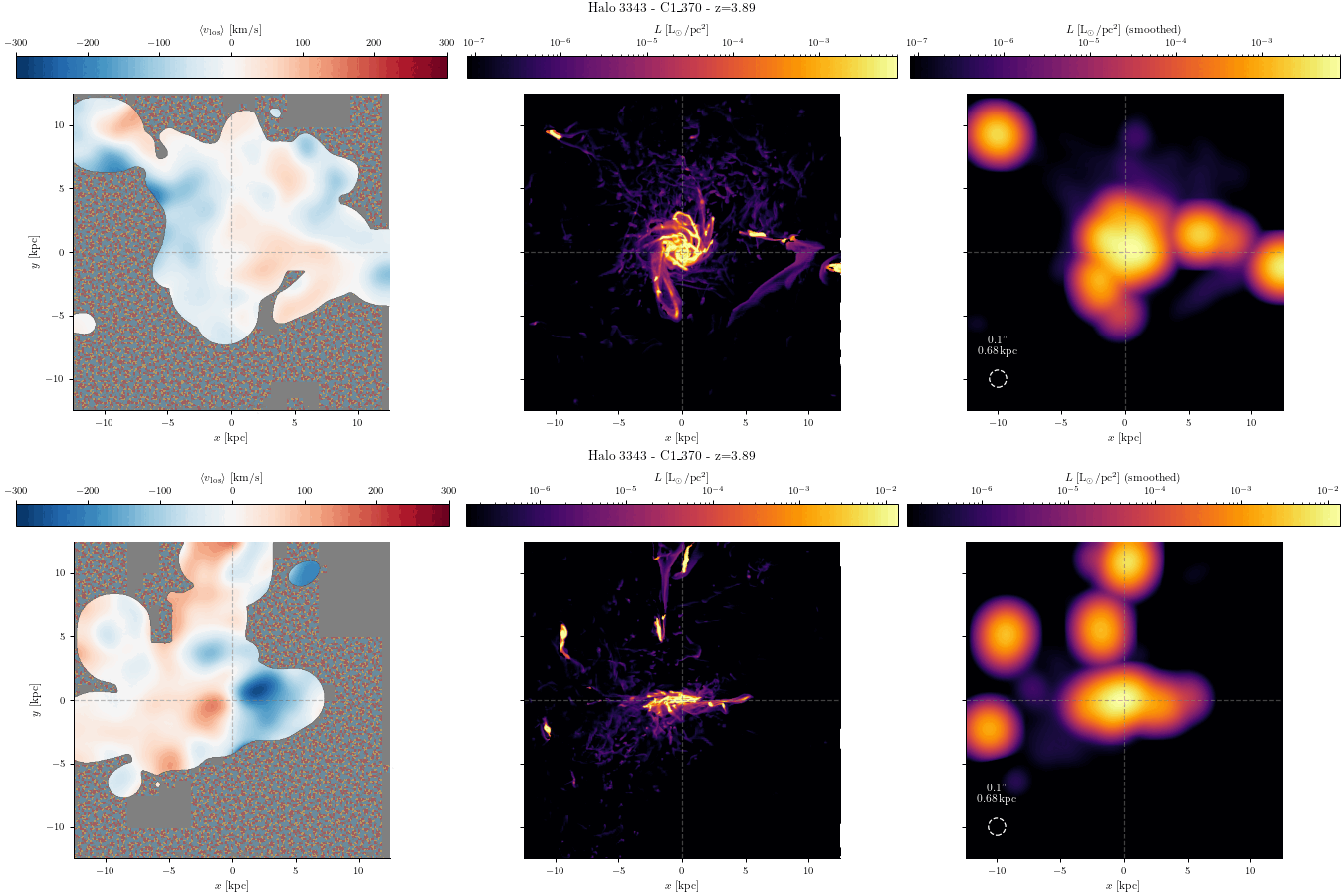
\(L=\textcolor{green}{\epsilon(n_\mathrm{X},T)} \textcolor{red}{n_\mathrm{X}n_\mathrm{e}}\bigotimes\mathrm{PSF}\)
Tabulated
From simulation

PRELIMINARY RESULTS

PRELIMINARY RESULTS
High-\(z\) cold disks?

\(M_\star \approx 10^{10}\,M_\odot, \quad z=4,\quad r>R_\mathrm{vir}/4\)
Overall trend:
lower-ionization lines damped with neq
\(\mathrm{CII\, 158µm}\)
\(\mathrm{OIII\, 88µm}\)
Take-home messages
- Megatron simulation suite
200,000+ spectra in 4 “ISM” runs (\(z\gtrapprox 8\)) ⇒ Katz, CC+ Wednesday
3+1 “CGM” runs (\(z\gtrapprox 3.5\)) ⇒ CC+ Wednesday
Link to low-\(z\) UFDs ⇒ Rey, ..., CC+ Wednesday
Properties of Pop. III stars ⇒ Storck, ..., CC+ Thursday
Sensitivity of line diagnostics to subgrids ⇒ Choustikov, ..., CC+ Thursday
Origin of steep \(\beta\) slopes ⇒ Katz, CC+ Thursday
- CGM (incl. inner CGM!) is out-of-equilibrium
Assuming PIE leads to 0.5 dex (median), and factors of
2-3× on individual line of sight
- High-\(z\) kinematics
Very easy to make ALMA-like maps (or JWST IFU)
from \(z=3-15\) and \(M_\star\lessapprox 10^{10}\,M_\odot\)


Model [i]
- Based on RAMSES-RT (Rosdahl+13)
- Out-of-equilibrium chemistry (Katz 23)
Primordial species: \(\text{H~{\small I}-{\small II}}\), \(\text{He~{\small I}-{\small III}}\), \(e^{-}\)
Metal ions: \(\text{C~{\small I}-{\small VI}}\), \(\text{N~{\small I}-{\small VII}}\), \(\text{O~{\small I}-{\small VIII}}\), \(\text{Ne~{\small I}-{\small X}}\), \(\text{Mg~{\small I}-{\small X}}\), \(\text{Si~{\small I}-{\small XI}}\), \(\text{S~{\small I}-{\small XI}}\) & \(\text{Fe~{\small I}-{\small XI}} \)
Molecules: \(\text{H}_2\) & \(\text{CO}\) - Dust model (Rémy-Ruyer+14)
Assuming dust-to-gas ratio - Heating & Cooling
photoheating, photoelectric heating, excitation/dissociation heating, primordial, dust recombination, dust-gas collisions, metal lines- \(\text{C~{\small I}}\), \(\text{C~{\small II}}\), \(\text{N~{\small II}}\), \(\text{O~{\small I}}\), \(\text{O~{\small III}}\), \(\text{Ne~{\small II}}\), \(\text{Si~{\small I}}\), \(\text{Si~{\small II}}\), \(\text{S~{\small I}}\), \(\text{Fe~{\small I}}\), \(\text{Fe~{\small II}}\)









\(\text{O\small{II}}\)
\(\text{O\small{I}}\)
\(\text{N\small{I}}\)
\(\text{Mg\small{II}}\)
\(\text{Ne\small{II}}\)
\(\text{CO}\)
\(\rho\)
\(v_r\)
\(\text{O\small{III}}\)
Model [ii]
-
Turbulence-based star formation (Padoan & Nordlund 11, Agertz+21)
\(\dot{\rho_\star} = \varepsilon_\star\rho/t_\mathrm{ff}\)- if \(Z<10^{-6}Z_\odot\) ⇒ Pop. III
- if \(Z\geq10^{-6}Z_\odot\) ⇒ Pop. I & II, Kroupa
- \(M_\star = 500\,\mathrm{M}_\odot\)
\(M_{\star,\rm III} \sim 100\,\mathrm{M}_\odot\) - Feedback (Agertz+21; Rey+23)
core-collapse SN, type Ia, winds + HN (Nomoto+06). - Yields (Limongi & Chieffi 18)
AGB winds (Ritter+18)

Model [iii]
- MW analogue @ \(z=0\)
- Genetically engineered to form earlier
ICs generated withgenetIC - 2 main runs
- constant physical \(\Delta x_\mathrm{min} \approx 20-40\,\mathrm{pc}\)
3 runs with ≠ ICs -
constant comoving \(\Delta x_\mathrm{min}(z=2) = 20\,\mathrm{pc}\)
\(\Delta x_\mathrm{min}(z=5)=10\,\mathrm{pc}\)
\(\Delta x_\mathrm{min}(z=14)=4\,\mathrm{pc}\)
3 runs: efficient feedback, variable IMF, hypernova
- constant physical \(\Delta x_\mathrm{min} \approx 20-40\,\mathrm{pc}\)

- Early forming MW mass galaxy
- \(1.6\times 10^{4}\mathrm{M}_\odot\) DM, \(500\, \mathrm{M}_\odot\) Pop. II stars, individual Pop III stars, \(1\, \mathrm{pc}\) resolution at first star formation
- IMF sampled chemical enrichment from individual stars for all relevant elements
- SN (CC, Ia, HN, PISN), Winds → follows Vintergatan (validated for MW galaxies at z = 0)
- 81 species chemistry coupled to 8 bin RT
- PRISM ISM model
- Enhanced resolution in the CGM
- Calibration sims with IMF variations and physical model variations

Introducing MEGATRON
Processes that control ion and molecular properties:
- Collisional, photo, cosmic-ray ionization
- Radiative, dielectronic, dust recombination
- Charge exchange

RAMSES-RTZ + PRISM: Non-equilibrium chemistry coupled to on-the-fly radiative transfer
Processes that control gas temperature:
- Cosmic-ray, photo, photo-electric, H2, dust heating
- Primordial, \(\mathrm{H}_2\), CO, metal, dust* recombination, dust-gas collisional cooling
- Adiabatic (expansion), shocks (e.g. SN, turbulence), gravitational, etc.
Katz, CC 2024
\(\Sigma\)OI
\(\Sigma\)OII
\(\Sigma\)OIII
Create “twin” simulation relaxed to photo-ionization equilibrium (PIE):
- Haardt-Madau UV bg,
- Local Habing field (\(6-13.6\,\mathrm{eV}\)),
- Dust-to-gas ratio (Rémy-Ruyer+14),
- Iterate until
\(\dfrac{\mathrm{d} n_{X_i}}{\mathrm{d} t} = 0\quad\) at fixed \(T\).
Code: Katz & CC, in prep.
Electron abundances


\(M_\star \approx 10^{10}\,M_\odot, \quad z=4\)
Effect on \(\mathrm{He\,III}\)
Data within \(r>R_\mathrm{vir}/4\)




\(M_\star \approx 10^{10}\,M_\odot, \quad z=4\)


Effect on \(\mathrm{He\,II}\)
\(M_\star \approx 10^{10}\,M_\odot, \quad z=4\)


Overall trend:
high-ionization lines boosted with neq
\(M_\star \approx 10^{10}\,M_\odot, \quad z=4,\quad r>R_\mathrm{vir}/4\)

\(M_\star \approx 10^{10}\,M_\odot, \quad z=4,\quad r>R_\mathrm{vir}/4\)
Overall trend:
intermediate-ionization lines unchanged

Tillson+15

Dekel&Birnboim 06
High-\(z\):
most of mass + AM flow along filaments
⇒ Natural interface between cosmo scales & galaxy formation
Circum Galactic Medium (\(r>R_\mathrm{vir}/3\))
HeII @ (PIE)
\(M=1.2\,10^9\,\mathrm{M_\odot}\)
HeII @ (neq)
\(M=8.8\,10^8\,\mathrm{M_\odot}\)
+\(30\%\)
[CIII]\(\lambda\lambda 1907\rm Å\) @ (PIE)
[CIII]\(\lambda\lambda 1907\rm Å\) @ (neq)
[CIII]\(\lambda\lambda 1907\rm Å\) @ (PIE)
[CIII]\(\lambda\lambda 1907\rm Å\) @ (neq)
[OIII]\(\lambda\lambda 1664\rm Å\) @ (PIE)
[OIII]\(\lambda\lambda 1664\rm Å\) @ (neq)
[OIII]\(\lambda\lambda 1664\rm Å\) @ (PIE)
[OIII]\(\lambda\lambda 1664\rm Å\) @ (neq)
Cooling length refinment
Refining where
\( \Delta x > 2 \sqrt{\dfrac{P_\mathrm{th}}{\rho}}\times {t_\mathrm{cool}},\)
(Rey+23)
- up to \(80\,\mathrm{pc}\)
- turned on at key moments




Cooling length refinment
\(+120\,\mathrm{Myr}\)




Quasi-Lagrangian + Jeans
Quasi-Lagrangian + Jeans + CGM ref
Cooling and chemical timescales go as \(n^2\)

Observables in the CGM?
Absorption
Emission

Zou+24

Pen+25 (\(z\approx2.8\))
⇒ Natural interface between cosmo scales & galaxy formation
Circum Galactic Medium (\(r>R_\mathrm{vir}/3\))
Modelling challenge:
- space filling (\(\sim 30\times\) more \(V\) in CGM than ISM);
- low-density (\(\lessapprox 10^{-2}\,\mathrm{m_p/cm^{-3}}\));
- multiphase (see rev. by Fumagali 24);

Gible project, Ramesh+24
(My) route to high-\(z\) kinematics
- Effect of cosmo. env. (Musso+19, Kraljic+20,21, Cadiou+21, Storck+24)
- Cosmology-galaxy connection (Cadiou+21)
- Cosmological accretion (Cadiou+19, Kocjan+24)
- But what are we actually observing? This talk




Low grav. tides
Large grav. tides
- cosmological environment \(\sim 50-100\,\mathrm{Mpc}\)
- resolve Strömgren spheres \(\sim 10\,\mathrm{pc}\)
- radiative-transfer
- proper multi-phase ISM \(T \lesssim 10^4\,\mathrm{K}\)
- Track ion abundances out-of-equilibrium
Wishlist for proper modelling of emission lines + kinematics
Background: Vintage Gordon (follow-up of Vintergatan) simulation
(PI: Cadiou)



\(t_\mathrm{chem} \propto 1/n^2\)
\(t_\mathrm{dyn} \propto 1/\sqrt{n}\)
\(t_\mathrm{burst} \sim 10-100\,\mathrm{Myr}\)

Halo-mass—stellar-mass relation
VG: Vintergatan (Agertz+21)
⇒ Well-regulated by \(z=0\)
High-resolution early \(<1\mathrm{pc}\)
Constant resolution \(\sim 20\,\mathrm{pc}\)
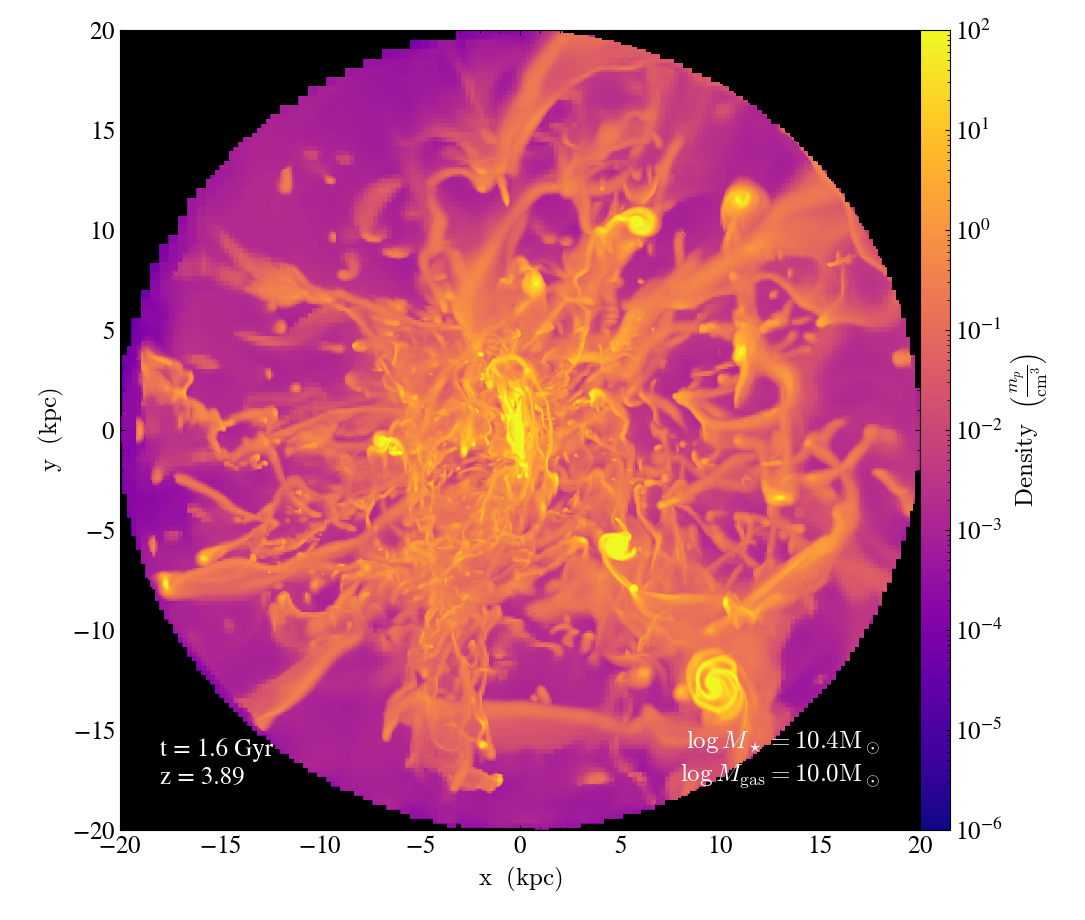
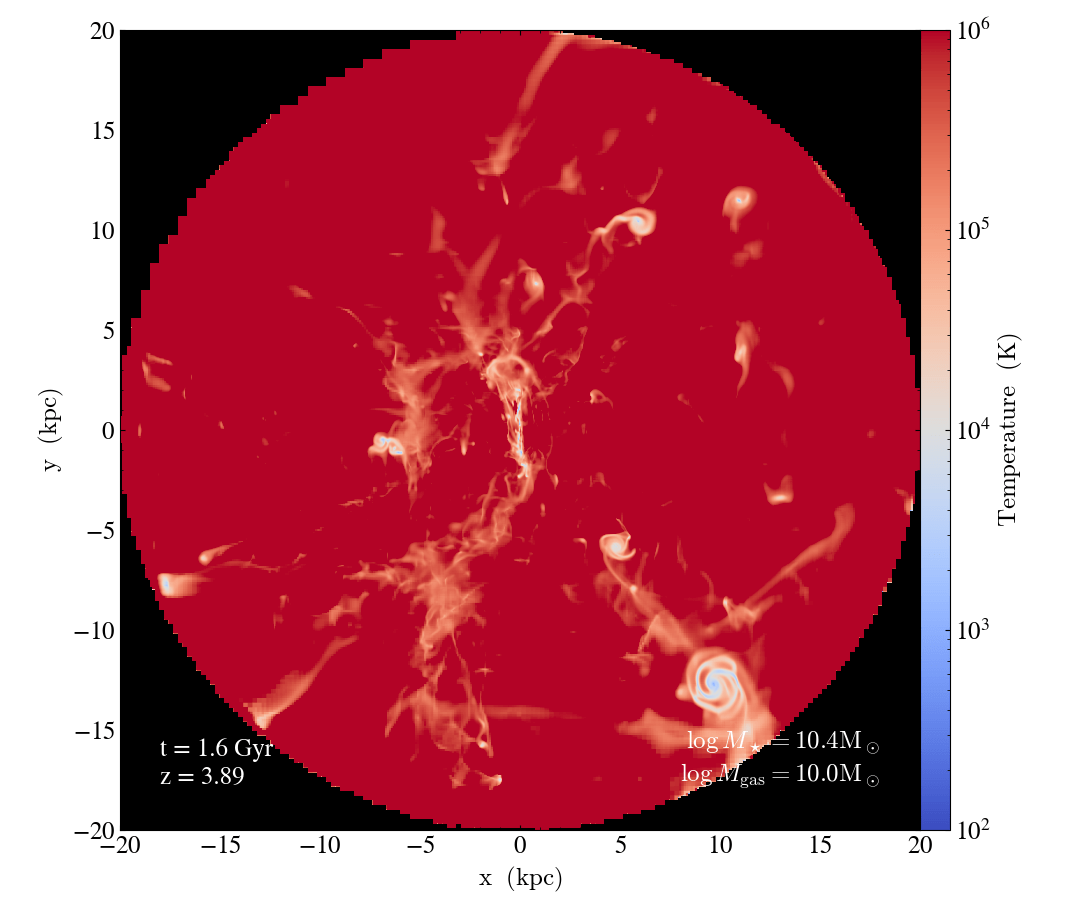

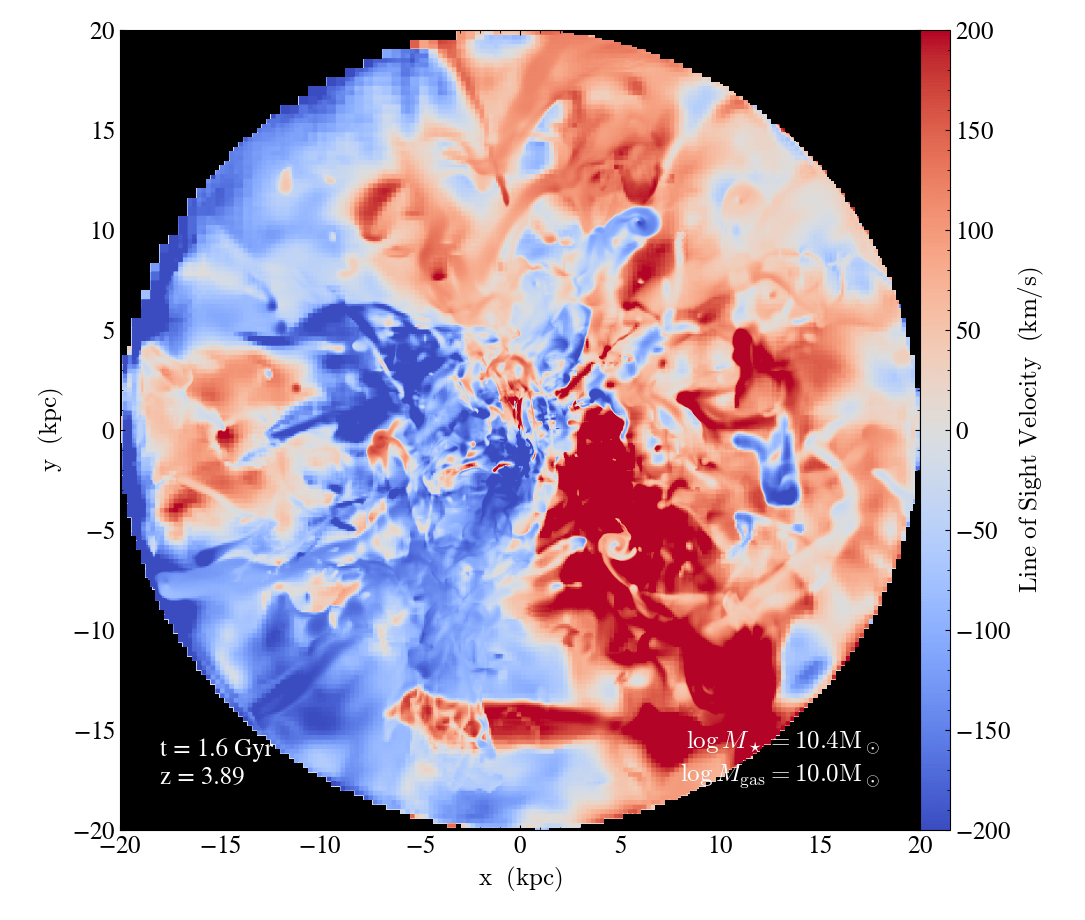


Most massive galaxy, edge-on
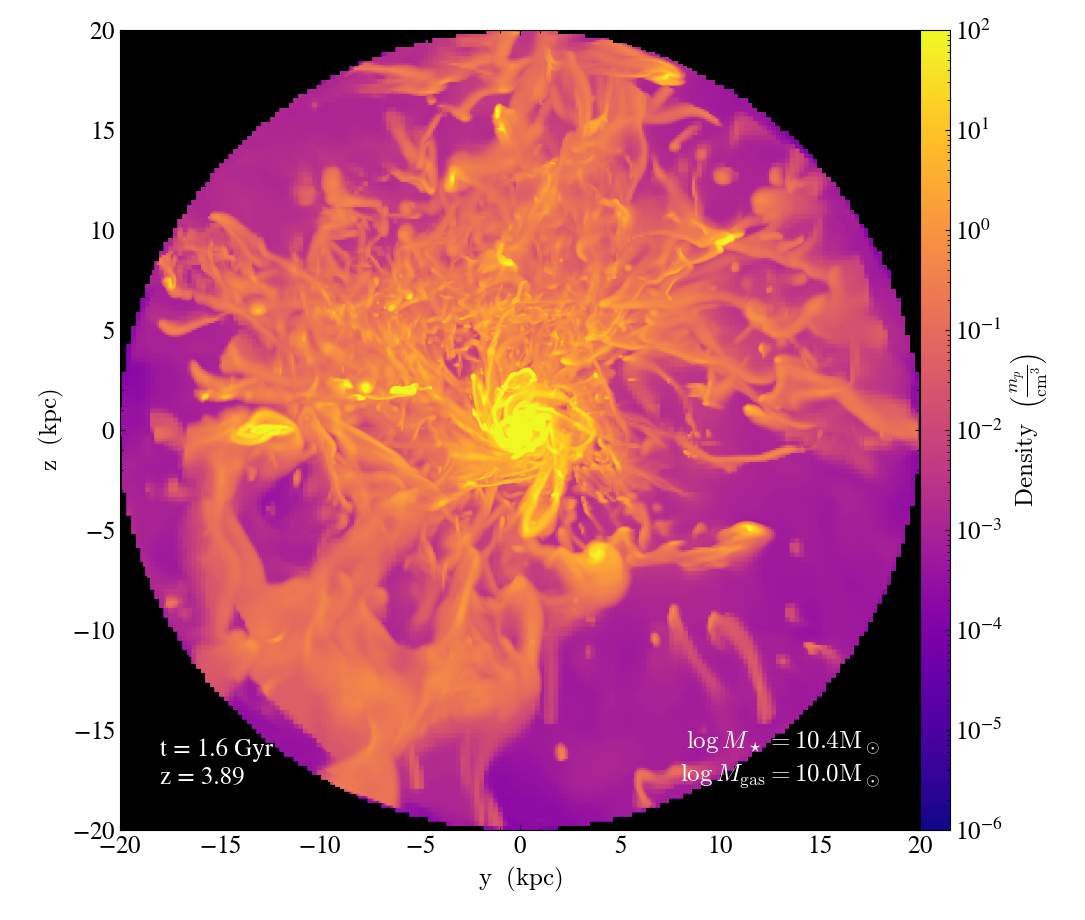
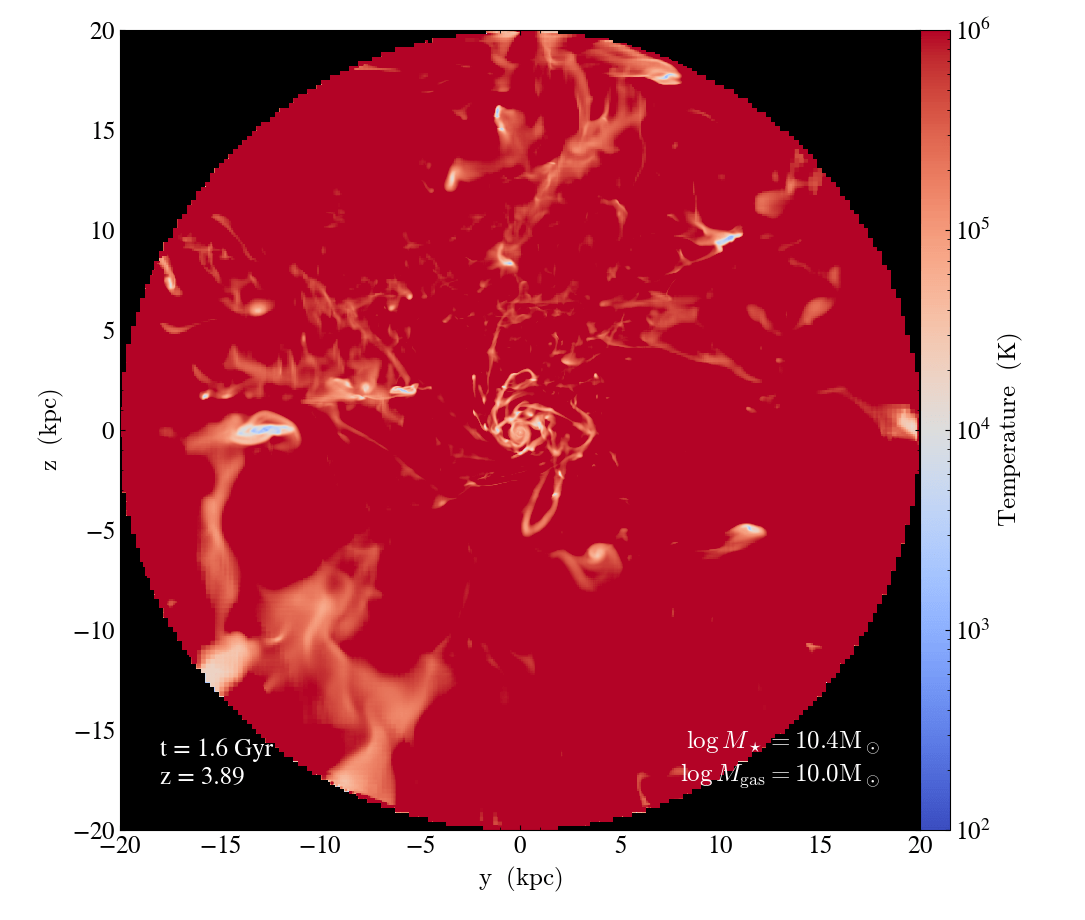


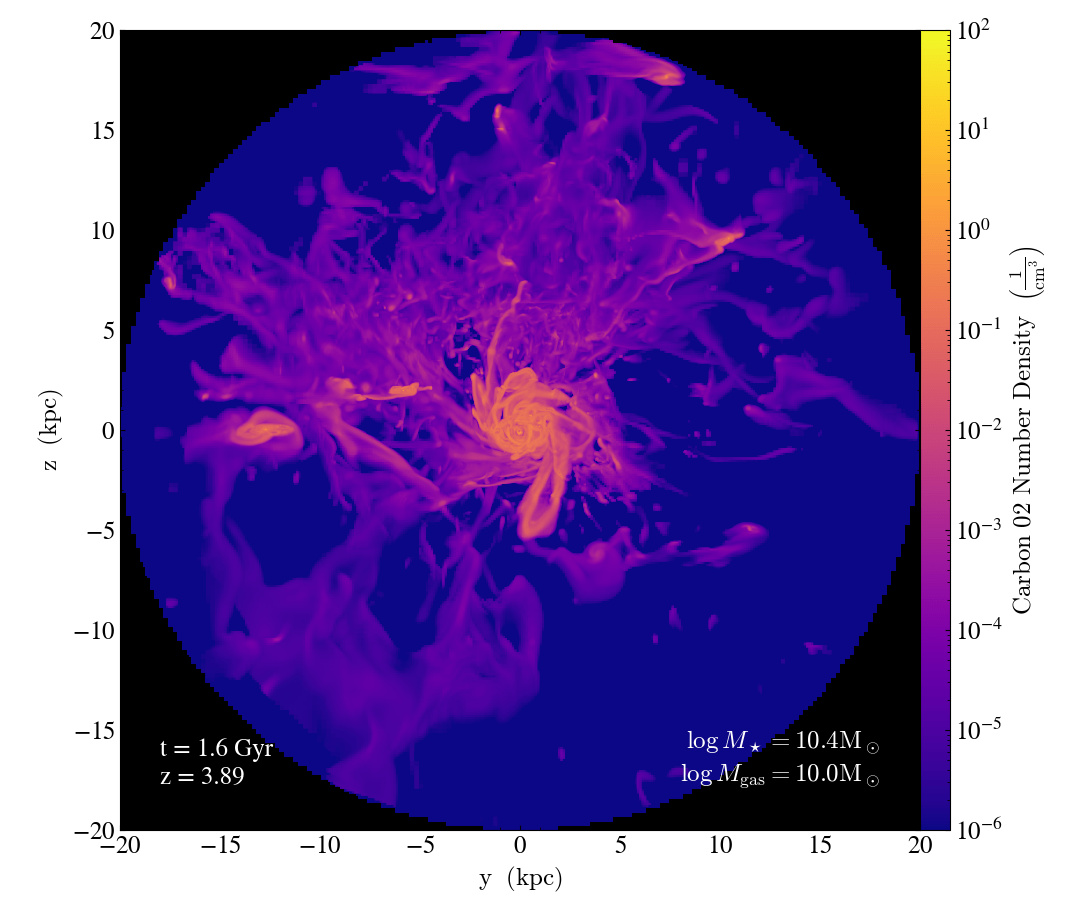

Most massive galaxy, face-on
Difference \([\mathrm{C{\small{II}}}]\)-weighted vs. \(n_\mathrm{H}\)-weighted
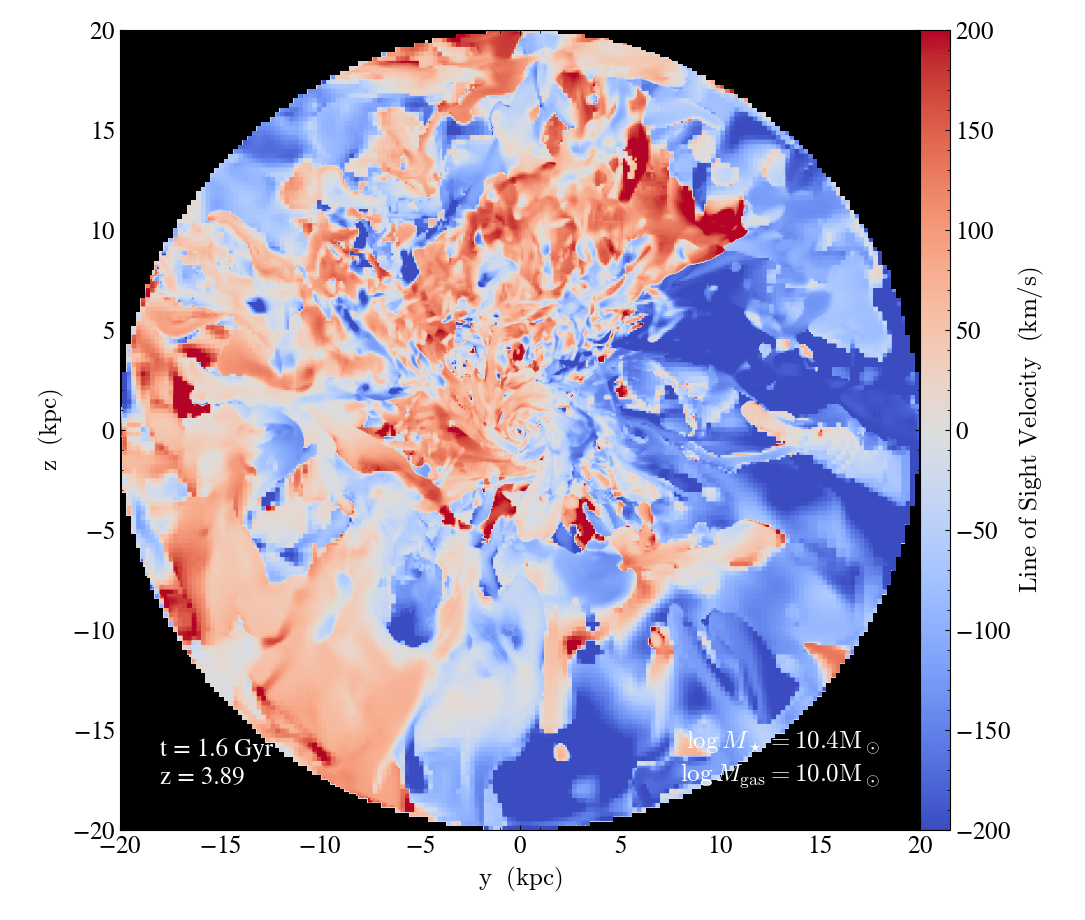
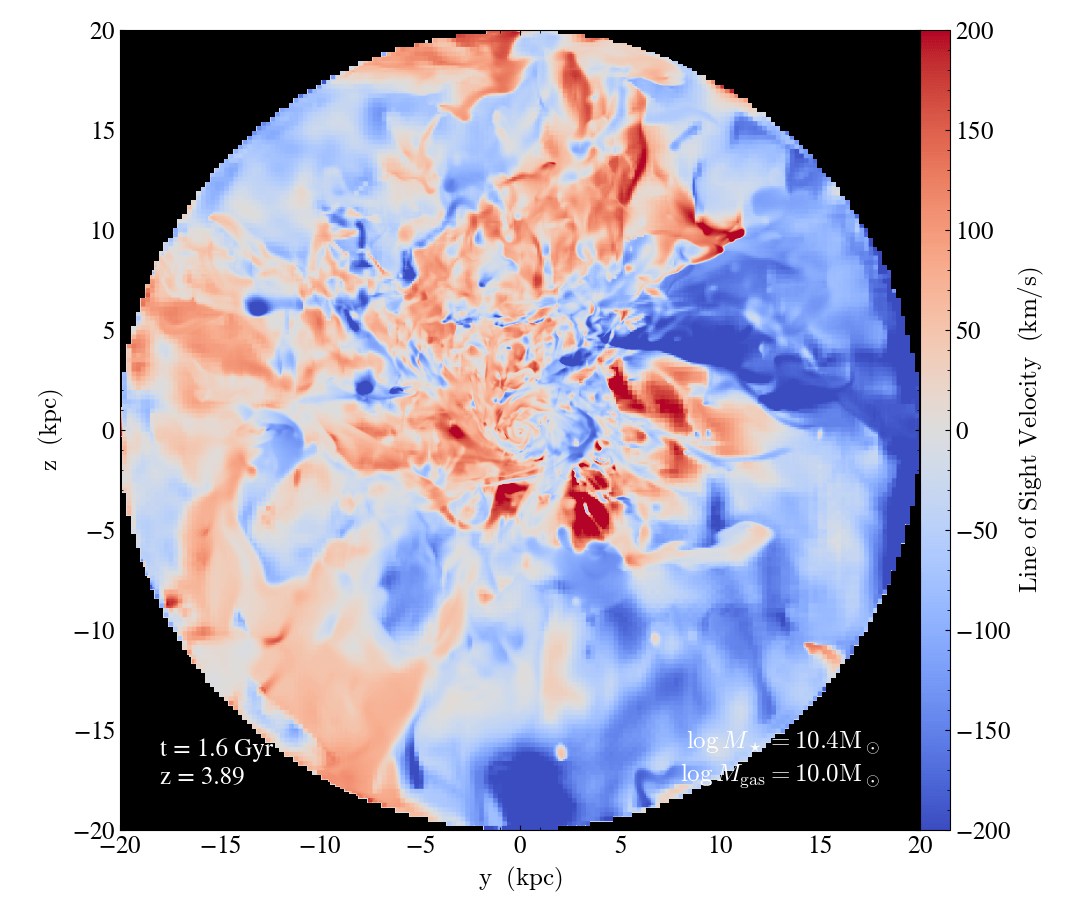
results
Stacked profiles
36 galaxies @ \(z=10\)
\(8.3\leq\log(M_\star/\mathrm{M}_\odot)\leq 10.0\)
⚠️ PRELIMINARY ⚠️
⚠️ PRELIMINARY ⚠️
⚠️ PRELIMINARY ⚠️
⚠️ PRELIMINARY ⚠️
⚠️ PRELIMINARY ⚠️
⚠️ PRELIMINARY ⚠️
⚠️ PRELIMINARY ⚠️
⚠️ PRELIMINARY ⚠️
⚠️ PRELIMINARY ⚠️
⚠️ PRELIMINARY ⚠️
⚠️ PRELIMINARY ⚠️
⚠️ PRELIMINARY ⚠️
⚠️ PRELIMINARY ⚠️
⚠️ PRELIMINARY ⚠️
⚠️ PRELIMINARY ⚠️





Only gas within \(\pm0.5\,\mathrm{kpc}\) height
All gas

Does non-equilibrium cooling matter?
Switching to equilibrium cooling
- same stellar mass, but
- ISM has much less cold gas


Katz 22
Results from Eddie

Me
Tracer particles
High-cadence sampling
Puns

Martin Rey
Pop II modeling
Cooling length refinment
ICs generation

Harley Katz
RAMSES-RTZ
Pop III modeling
Calibrations



Stellar mass vs. Halo mass
CP not too bad compared to Vintergatan (Rey+23)
CC underregulates
Constant comoving
Constant physical


Varying IMF to the rescue?
Same model, but high-\(z\) dwarf \(M_\mathrm{dm}=10^{9}\,\mathrm{M}_\odot\) at \(z=6\)

Cooling length refinment
Refining where
\( \Delta x > 2 \sqrt{\dfrac{P_\mathrm{th}}{\rho}}\times \dfrac{1}{\Lambda_\mathrm{net}},\)
(Rey+23)
- up to \(80\,\mathrm{pc}\)
- turned on at key moments
\(z=5.8\)
\(z=5.8(+2\,\mathrm{Myr})\)
\(20\,\mathrm{kpc}\)




Cooling length refinment


How much does it cost?
\(\times 3\)
\(\times 70\)!

Conclusions
It works and stay tuned for results?


Early Milky-Way in the Megatron sims
By Corentin Cadiou
Early Milky-Way in the Megatron sims
- 64



